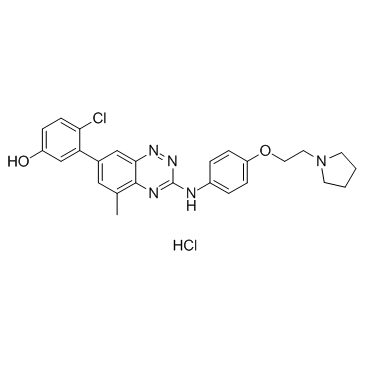TG 100572 Hydrochloride |
| Catalog No.GC37772 |
TG 100572 Hydrochloride is a multi-targeted kinase inhibitor which inhibits receptor tyrosine kinases and Src kinases; has IC50s of 2, 7, 2, 16, 13, 5, 0.5, 6, 0.1, 0.4, 1, 0.2 nM for VEGFR1, VEGFR2, FGFR1, FGFR2, PDGFRβ, Fgr, Fyn, Hck, Lck, Lyn, Src, Yes, respectively.
Products are for research use only. Not for human use. We do not sell to patients.

Cas No.: 867331-64-4
Sample solution is provided at 25 µL, 10mM.
TG 100572 Hydrochloride is a multi-targeted kinase inhibitor which inhibits receptor tyrosine kinases and Src kinases; has IC50s of 2, 7, 2, 16, 13, 5, 0.5, 6, 0.1, 0.4, 1, 0.2 nM for VEGFR1, VEGFR2, FGFR1, FGFR2, PDGFRβ, Fgr, Fyn, Hck, Lck, Lyn, Src, Yes, respectively. VEGFR1|2 nM (IC50)|VEGFR2|7 nM (IC50)|FGFR1|2 nM (IC50)|FGFR2|16 nM (IC50)|PDGFRβ|13 nM (IC50)
TG 100572 shows sub-nanomolar activity against the Src family as well as RTK such as VEGFR1 and R2, FGFR1 and R2, and PDGFRβ. TG 100572 inhibits vascular endothelial cell proliferation (ED50=610±71 nM) and blocks VEGF-induced phosphorylation of extracellular signal-regulated kinase. TG 100572 induces apoptosis in rapidly proliferating, but not quiescent, endothelial cell cultures[1]. TG 100572 is shown to inhibit hRMVEC cell proliferation, with an IC50 of 610±72 nM. This suggests that TG 100572 has the therapeutic potential to inhibit VEGF function in ocular endothelial cells, a contributing factor to pathological angiogenesis in diseases such as AMD and PDR[2].
Systemic delivery of TG 100572 in a murine model of laser-induced choroidal neovascularization (CNV) causes significant suppression of CNV, but with an associated weight loss suggestive of systemic toxicity[1]. A concentration of 23.4 µM (Cmax) of TG 100572 is reached in 30 min (Tmax)=0.5 h) in the choroid and the sclera. However, the levels of TG 100572 in the retina are relatively low. The half-life of TG 100572 in ocular tissues is very short; hence, the compound is administered topically minimum t.i.d. to maintain appropriate drug levels in the eye. The maximum concentration one can achieve in formulations using TG 100572 is 0.7% w/v[2].
[1]. Doukas J, et al. Topical administration of a multi-targeted kinase inhibitor suppresses choroidal neovascularization and retinal edema. J Cell Physiol. 2008 Jul;216(1):29-37. [2]. Palanki MS, et al. Development of prodrug 4-chloro-3-(5-methyl-3-{[4-(2-pyrrolidin-1-ylethoxy)phenyl]amino}-1,2,4-benzotriazin-7-yl)phenyl benzoate (TG100801): a topically administered therapeutic candidate in clinical trials for the treatment of age-related macular degeneration. J Med Chem. 2008 Mar 27;51(6):1546-59.
Average Rating: 5 (Based on Reviews and 33 reference(s) in Google Scholar.)
GLPBIO products are for RESEARCH USE ONLY. Please make sure your review or question is research based.
Required fields are marked with *




















